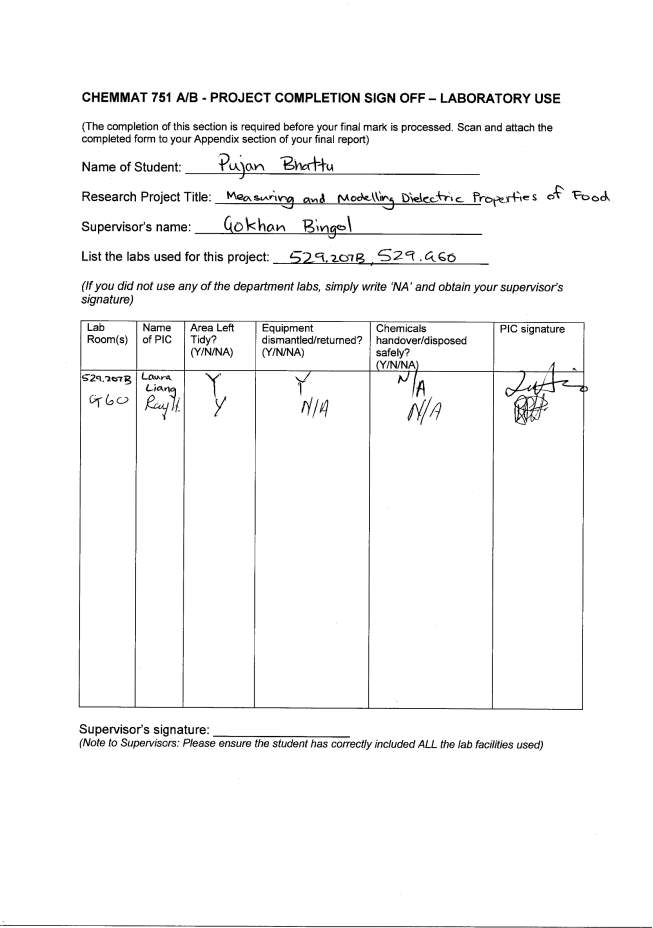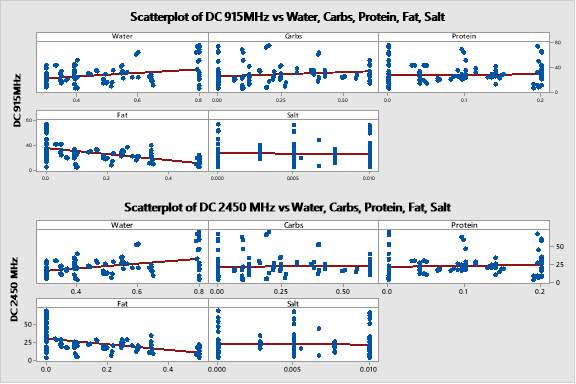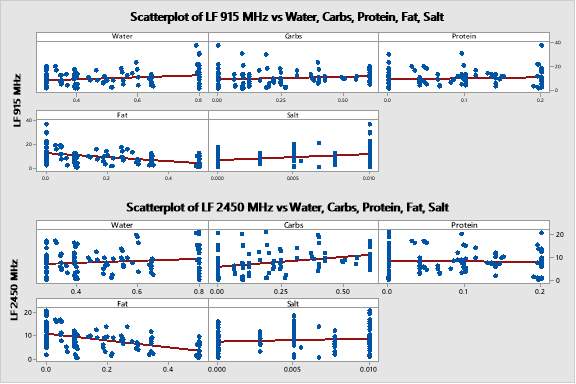Measuring and Modelling Dielectric Properties of Food Solutions
Info: 13396 words (54 pages) Dissertation
Published: 10th Dec 2019
Tagged: Food and Nutrition
Executive Summary
Dielectric properties are the main parameters that are used to provide data on how materials are affected and interact with electromagnetic energy such as in a microwave. This research was based on measuring the dielectric constant and dielectric loss factors of test solutions. They were measured at different frequencies to see the response. The test solutions consisted of five components that imitate those found in real life. These components of interest were Water, Carbohydrates, Protein, Salt and Fat. The experimental procedure consisted of varying the composition of the solution with the five components to observe how their dielectric properties are affected.
Mixture Design using Extreme Vertices was used through the Minitab Software. Mixture Design was chosen as they are a special case of Response Surface Design in which the product under investigation is made up of several component or ingredients. This design consisted of a total of 125 test runs. Each run was made up to a total of 50g sample, each with varying proportion of the 5 components. The sample was then tested using the Network Analyzer between the frequency of 300 MHz and 3 GHz.
The results obtained were then analysed and multiple regression performed. An equation to model the response to the variation in composition was constructed. The output from this equation was compared to the original experimental results using one-way ANOVA. The p-values obtained indicated the null hypothesis can be accepted. There is no difference in means between the data obtained through the experimental procedure and from the regression equations. It is recommended that further work is required to test the validity of the equation and check that it performs to a sufficient level and holds true.
Table of Contents
2.3 Factors Affecting Dielectric Properties
2.4 Effect of Sugar, Starch and Salt
2.5 Determining Dielectric Properties
3.1 Preparation of Test Solutions
3.2 Measuring Dielectric Properties using the Network Analyzer
3.3 Operation of Ultrasound Processor
4.2 Regression Analysis of Data
4.1 Errors Introduced in Experimental Procedure
5.0 Conclusion and Future Work
Appendix A: Safety and Laboratory Use
Appendix C: Experimental Runs and Results
Appendix D: Calibration Measurement of Distilled Water
Appendix E: Scatterplots of Dielectric Constant and Loss Factor
Appendix F: One-Way ANOVA Results
List of Figures
Figure 2: Sampling Probe immersed into the test solution
Figure 6: Dielectric constant of distilled water during calibrations
Figure 7: Variations during calibration of distilled water
List of Tables
Table 1: Composition range of the test solutions
Table 2: Regression equations for the dielectric properties for the test solutions
Table 3: P-values from the one-way ANOVA performed with the experimental and calculated values of
ε’and
Microwave Processing of food is a growing industry in the food sector. Dues to this, the dielectric properties of food have become an important parameter in food engineering. The interest in these properties are mainly focused on how they affect the heating of the food when used in a high frequency microwave. Now there is a growing sense in the food industry of using microwaves to heat food, especially commercially. The use of microwaves to heat food products offers advantages over traditional methods. These advantages include the instant heating of product, low maintenance associated with it and the ease of use.
Dielectric Properties are the main parameters that are used to provide data on how materials are affected and interact with electromagnetic energy such as in a microwave. This data is crucial in determining how food material responds to changes in frequency and temperature. Thus, dielectric properties of food have become a parameter of increasing importance in the field of food engineering and technology.
This research is based on measuring the dielectric constant and dielectric loss factors of test solutions. This will be measured at different frequencies to see the response. The test solutions will consist of five components that imitate those found in real life. These components of interest are Water, Carbohydrates, Protein, Salt and Fat. The experimental procedure will consist of varying the composition of the solution with the five components to observe how their dielectric properties are affected.
Analysis will be done on the data that is captured. An equation to model the response to the variation in composition will be constructed. This equation will then be applied to food items with known composition to test their validity against known dielectric properties.
The objective of this project is to find a model that can be used to predict the dielectric properties of food with known composition. These models will first be constructed by getting base figures form known composition.
- Measuring the dielectric constant and the loss factor of test solutions with known composition under various frequencies
- Creating a model that can be used to predict dielectric constant and loss factor from known composition
- Applying the model to known food items to compare model versus known dielectric properties
Microwaves are electromagnetic waves within a frequency band of between 300MHz and 300GHz. They fit between radio frequency at the lower range and by infrared and visible light in the upper spectrum.
Microwaves are directly adjacent to radio frequencies. This frequency is generally used for radio and television broadcast. Microwave frequency range, are also used for telecommunication purposes, such as for mobile networks, radars and wireless networks. In order to prevent contamination of the broadcasting signals and interference, certain frequency bands are reserved for Industrial, Scientific and Medical (ISM) applications. For microwaves dielectric heating purposes, these bands are 433, 915, 2450 and 5800 MHz (Watkins, 2012). Most of the domestic household microwaves operate on a frequency of 2450 MHz. Industrial microwaves operate on 915MHz frequency (Regier, Knoerzer & Schubert 2017).
With the progress in current lifestyle enjoyed by people, microwaving heating technology brings added benefits to the heating of food. These include the quick heating of food, ease of use and low maintenance associated with it. The combination of traditional method of heating (air drying) combined with microwave heating also brings added benefits to the food industry as it can reduce the processing times, energy consumption and reduce time taken to process those foods currently. However, the inconsistent heating of food associated with microwaves remains the major obstacle on fully utilising this technology (Umesh Hebbar, Rastogi 2012).
Green energy regulations call from more efficient use of energy and this is where microwave heating has an advantage over traditional means due to its minimal processing of materials. This is where it shows its potential promising future. They are also energy efficient can be used with other heating methods.
Microwave heating is a result of interactions that occur between dielectric material and electromagnetic waves. Dielectric properties govern the efficiency and quality of the heating process. An oscillating electric field, when applied to a polar dielectric material, leads to the dipoles within the material to align themselves with the field. The polarisation rate of change leads to the molecules vibrating as they re-orientate to the oscillating waves. This in effect leads to the increase in molecular kinetic energy which is then converted to heat (Meda, Orsat & Raghavan 2017).
The dielectric properties of food that are of most interest can be defined in terms of their complex relative permittivity. It is expressed as
ε*=ε’-jε” Eq. 1
ε’
is commonly known as the dielectric constant while
ε”is the dielectric loss factor, while
j=-1. The dielectric constant
(ε’), shows the ability of a material to store energy while it is under the influence of an energy field. The loss factor
(ε”), affects both the energy absorption and attenuation and describe the ability to dissipate energy in response to an electric field, which commonly generates heat (Ikediala et al., 2000). The amount of thermal energy converted in food is proportional to the value of the loss factor (Tang, 2005).
This increase in temperature due to dielectric heating can be defined as
 Eq. 2
Eq. 2
Where
Cp(J kg-1°C-1) is the specific heat of the material, ρ (kg m-3) is the density of the material, E (V m-1) is electrical field intensity, ƒ (Hz) is the frequency, dT/dt (°C s-1) is the time rate of temperature increase. From the equation above, it can be concluded that the increase in time is proportional to the loss factor along with the electric field intensity, frequency and the time.
Another factor that is important is the penetration depth. This is the depth of a sample where the microwave power has dropped to approximately 36.8% of its transmitted power. The penetration depth is affected by both of
(ε”)and
(ε’)(Sosa-Morales et al., 2010).
 Eq. 3
Eq. 3
An alternative way of expressing this equation is
 Eq. 4
Eq. 4
Common foods have been found to have
(ε”)<25 , which implies a dp of 0.6 to 1 cm (Venkatesh, Raghavan 2004).
2.3 Factors Affecting Dielectric Properties
There are several important factors which lead to changes in dielectric properties. They consist of factors which relate to the nature of the product (composition, structure) while others are to do conditions when it is heated (temperature, frequency).
Dielectric constants are dependent of the chemical composition of the material. In food generally, it is mostly made of water and its content has a direct effect on heating. Water is the major absorber of the microwave energy in foods and due to this, the higher the water content, the better the heating (Venkatesh, Raghavan 2004). Ionic compounds such as salt also has a vast effect on these properties. Increasing of salt content from 0.8% to 2.8%, resulted in an increase in loss factor of mashed potatoes, while the dielectric constant was not affected (UAN et al., 2004).
With the exception of some materials that absorb no energy from microwaves, the dielectric properties of food vary with frequency. This is due to the polarisation of molecules that occur when an electrical field is applied. The molecules in the food oscillate to align with the electrical field applied. This oscillation in turn leads to an increase in kinetic energy which is then converted to heat. Thus, as the frequency is increased, this also leads to the heating done on the material (Meda et al., 2017).
2.4 Effect of Sugar, Starch and Salt
There has been various past research and measurements done on the effect of Sugar on dielectric properties. A past research done on measurement of sucrose, glucose and syrup found that frequency and concentration of the solution led to the varying of the complex permittivity (Kent, Kress-Rogers 1986). There was a great difference of values measured at 3.05 GHz and 2.8 GHz.
Starch containing solutions with up to 40% water was also tested. This carbohydrate-water mixture contained potato and wheat starch. The value of dielectric constant was found to be higher for potato starch than that of wheat starch at 10 GHz. The value of the loss factor for the potato starch is lower. It was also found that the loss factor for most starches decreased due to heating (Miller, Gordon & Davis 1991).
Salt ions have a great impact on the dielectric properties of food. The dielectric loss factor is increases with temperature as frequencies below 200 MHz. Increasing temperature leads to a reduction in dielectric loss factor between 200 MHz and 10 GHz (UAN et al., 2004, Gavish, Promislow 2016).
2.5 Determining Dielectric Properties
There are a few different ways of determining the dielectric properties. The main factors that lead to consideration of the method is the type of material, the required frequency range and accuracy, and availability and cost of equipment.
The three most popular methods of measuring the dielectric properties of food are open-ended coaxial probe, transmission line and, resonant cavity method. The probe method is based on a coaxial line that ends and makes contact with the material being tested. This method is the simplest to use and it doesn’t require the tested material to be of a particular size or shape or special containers (Ikediala et al., 2000).
The transmission line involves placing the testing sample inside a transmission line. This requires the cross section of the line to be filled with the sample precisely. This method is time consuming but is very accurate and sensitive in its measurement (Kudra et al., 1992). The cavity method involves a sample of known geometry to be placed in a cavity. It can be used to gauge accurate results and is useful for samples with low dielectric loss factor. A main concern is that this method can only be used to measure at a set frequency during each run.
The five components used to make up the test solutions consisted of Water (Distilled Water), Carbohydrates (Sugar), Protein (Whey Protein), Salt (Table Salt) and Fat (Canola Oil). The experiments consisted of varying the composition of the test solutions and recording their reading of dielectric constant and loss factor. The composition range of the five components were selected as shown in Table 1. These values were selected based on average food compositions (Sivakumaran, Huffman & Sivakumaran 2017).
Table 1: Composition range of the test solutions
| Component | Lower | Upper |
| Water | 30% | 80% |
| Carbohydrates (Sugar) | 0% | 60% |
| Protein | 0% | 20% |
| Fat (Oil) | 0% | 50% |
| Salt | 0% | 1% |
For the experiments, Mixture Design using Extreme Vertices was used through the Minitab Software. Mixture Design was chosen as they are a special case of Response Surface Design in which the product under investigation is made up of several component or ingredients. As the five components used in this experiment have to create a total mixture amount of 100%, Mixture Design was found to be the best fit experimental design. Due to the setting of lower and upper bounds of the component, Extreme Vertices Design was best suited for this design. As noted in Appendix B, the Mixture Design consist of a total of 125 runs.
The test solutions were made to be a total of 50g. The values of the component in each run is shown in Appendix C.
3.1 Preparation of Test Solutions
The solutions were all prepared in a jar before being tested. The jar was first tare weighed. Water was first weighed out onto the jar according to the required amount for the set run. This was followed by sugar, if it was required, on a sheet and then added to the jar. To assist in dissolving of the sugar particles, this solution was placed in a water bath with a set temperature of 40°C. Once the solution was dissolved, salt was then weighed out and added. Once dissolved, whey powder was weighed and added. This process was repeated with oil. Weighing of the materials were all done on the scales. The heat bath was set to a max of 40°C as protein enzymes begin to degrade at this temperature (Ferguson, Lurie & Bowen 1994). The temperature of the solution was checked to ensure it was below this temperature before any protein powder was added.
For solutions that did not contain oil, the solution was mixed only by hand shaking of the jar. This was done sufficiently to dissolve all particles of the solution. As oil is immiscible in water, for solutions that contained oil, further mixing was performed using an ultrasound processor.
3.2 Measuring Dielectric Properties using the Network Analyzer
The dielectric properties of the test solutions were all measured using the dielectric probe kit. This kit consists of an open-ended coaxial probe (Model 85070E, Agilent Technologies) that is connected to network analyzer (E5062A ENA Series Network Analyzer, Agilent Technologies). The network analyser once started was left to stabilise for an hour. Then the probe was attached to the network analyser and the measuring probe was attached to the measuring stand. Calibration of the probe was then performed. Calibration involved a three-step process involving open air, short circuit and lastly 25°C distilled water. Calibration was performed for the frequencies between 300MHz and 3GHz.



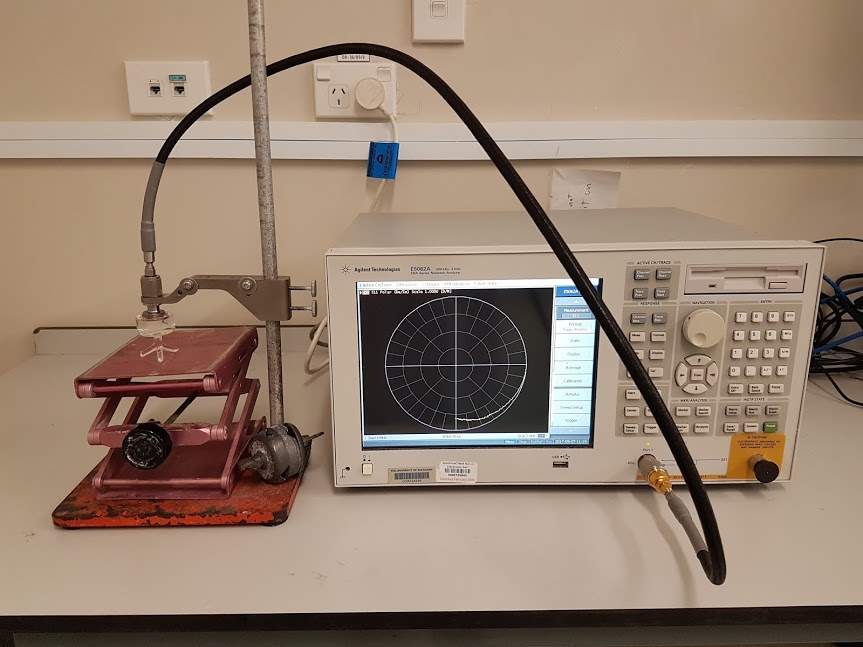
Open-ended coaxial probe
Network Analyser
Sampling beaker being tested
Figure 1: Layout of the equipment during the third stage of calibration and normal testing of samples
Occasionally, after calibration, the reading of the Distilled water would fluctuate as seen in Appendix D. When this occurred, the system was recalibrated until a smooth consistent curve was realised.
A 10mL sample was poured into a sampling beaker. The measuring probe was lowered to be fully immersed into the sample to be at least half submerged as seen in Fig. 2. The measurement was immediately triggered and a recording output was given. The temperature of the test solution was ensured to be between 20°C and 25°C before it was poured into the sample beaker. This was to ensure all reading were recorded at a similar temperature and avoid any fluctuations in readings.
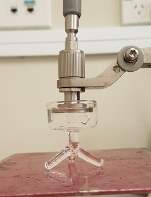
Figure 2: Sampling Probe immersed into the test solution
Between samples, the probe was cleaned with distilled water and then pat dried. When a solution with oil was measured, care was taken to clean the probe thoroughly. This was firstly done by use of Ethanol to cleanse any oil residues. The probe was then cleaned with distilled water and pat dried. As Ethanol was used, this could affect any new readings so recalibration had to be done on the unit. To reduce the time delay caused by the recalibration, the decision was made to test blocks of samples with oil in its composition. This ensured that the use of ethanol was not required to clean the probe for the consecutive samples and thus avoid the delay of recalibration.
3.3 Operation of Ultrasound Processor
The Ultrasound has the ability to be able to input time, temperature control, pulses, amplitude and energy input. Approximately 50mL of the test solution was poured into a beaker. The ultrasound mixer probe was lowered halfway into the solution. The processor was turned on. The time for mixing, maximum temperature and pulses were selected. The processor was then started until the solution was mixed to a homogenous solution.
As the ultrasound processor has an effect of heating up the solution as it operates, care had to be taken to monitor the temperature. To reduce the risk of overheating, the beaker that held the sample was placed in a larger dish with an ice and cold-water mixture. This helped to keep the temperature of the solution fairly consistent as the processor operated. As seen in Appendix E, there was a slow change from separate layers of water and oil to a homogenous solution.
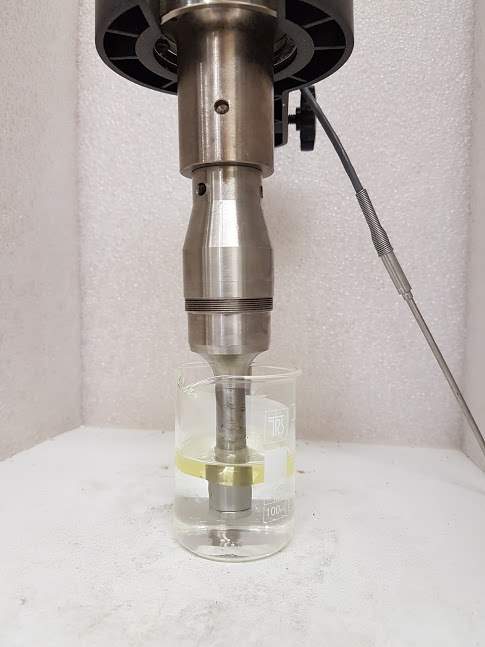
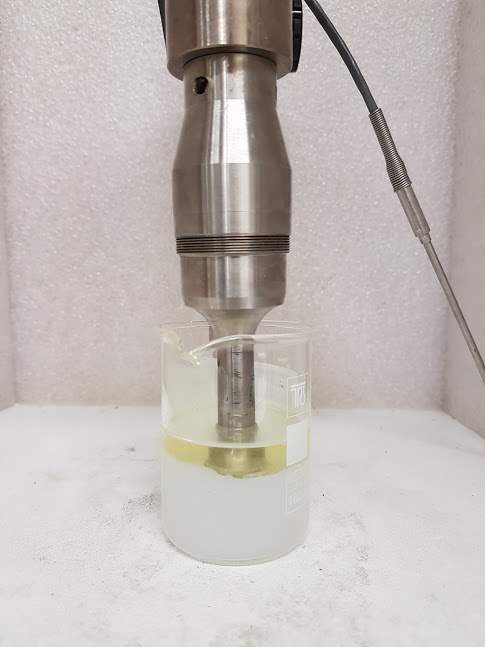
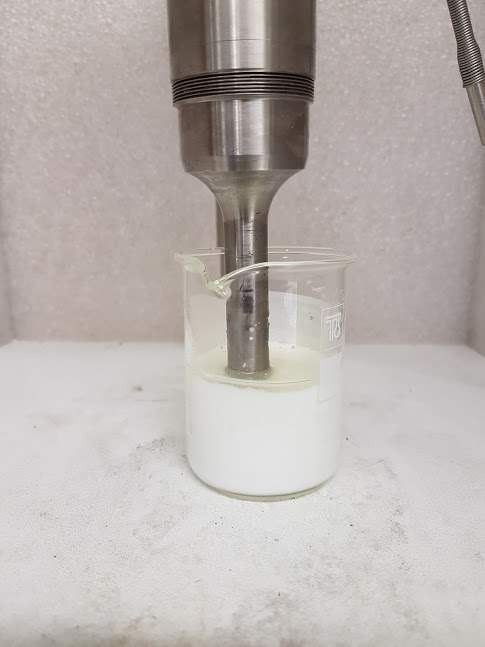
(b)
(a)
(c)
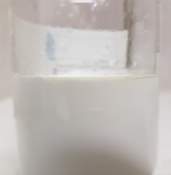
(d)
Figure 3: Mixing of Run 74. Consisting of 40g water and 10g oil. Pictures were taken at start (a), after 90 secs (b), after 360 secs (c) and after 720 secs (d)
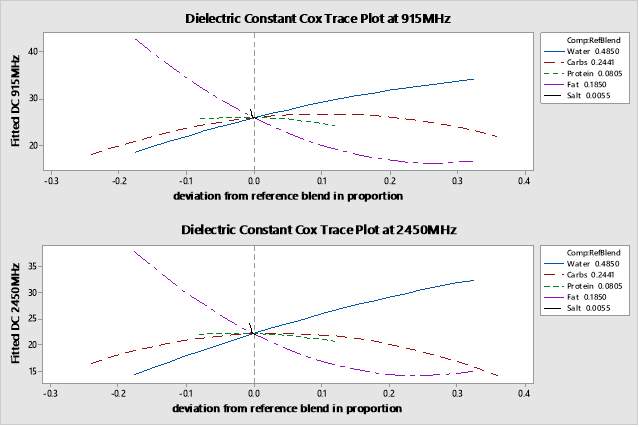
Figure 4: Cox Response Trace Plot showing the effect of components composition at 915MHz and 2450MHz on the dielectric constant
As seen in Fig. 3 for both frequencies, there is a similar change in dielectric constant as a result of proportion change of the components. As the proportion of Water increases at both frequencies, so does
ε’. For Carbohydrates, the change in concentration follows a concave function. Initially
ε’is low and rises as the concentration increases. At a certain proportion, approximately 0.25,
ε’starts to decrease. For Protein, there is a slight decrease in the value of
ε’as its proportion increases. With Fat, there is a large decrease in the
ε’reading as the fat proportion increases. For Salt there is a sharp decrease in
ε’as the proportion of salt increases. These trends are comparable to the scatter plot of
ε’against the five components proportion as shown in Appendix E.
The increase in water content in the test solutions leading to an increase in dielectric constant is consistent with what is expected in literature. It has been noted that higher moisture content leads to a higher loss factor (Komarov, V., Wang, S., & Tang, J, 2005). Higher water content leads to better heating in food. This is due to water absorbing majority of the energy in microwave heating. Microwave heating and thus dielectric constant is greatly affected by water (Nelson, Kraszewski 1990).
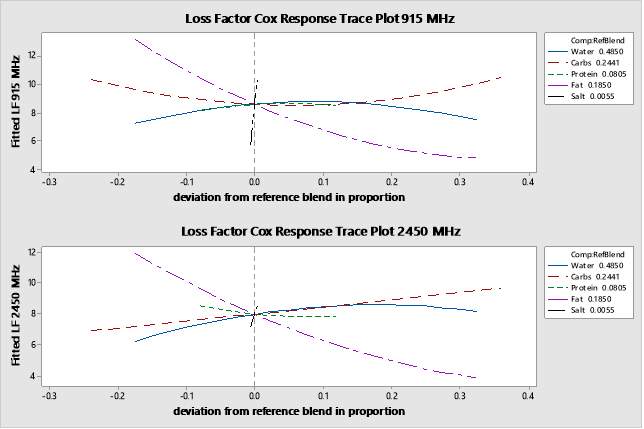
Figure 5: Cox Response Trace Plot showing the effect of components composition at 915MHz and 2450MHz on the loss factor
For the Loss Factor in regards to Water as seen in Fig. 4, there is a convex function relationship.
ε”initially rises but then starts decreasing for both frequencies. For carbohydrates, at 915 MHz, there is a concave relationship between the loss factor and increase in proportion of carbohydrates. At 2450 MHz, there is an almost linear relationship. Increase of fat concentration leads to a decrease in loss factor at both frequencies. Protein also exhibits different relationships at different frequencies. At 915 MHz, there is a slight concave function to the relationship. During 2450 MHz, there is a decrease in the loss factor as the proportion of protein increases. As the salt proportion increases there is a dramatic increase in loss at both frequencies. The gradient increase at 915 MHz is much higher. These trends are comparable to the scatter plot of
ε”against the five components proportion as shown in Appendix E where the degree of relationship is not as clear.
The increasing proportion of salt having a sharp increase in
ε”was consistent with a previously run experiment reported by (UAN et al., 2004). Salts or dissolved ions lead to reduction in polarisation of water and
ε’by binding water.
4.2 Regression Analysis of Data
Regression Analysis was performed on the data that was gathered from the experiment procedures. This was done for the dielectric constant and loss factor for both 915 MHz and 2450 Mhz. This was done to arrive at an equitation that would enable us to predict the dielectric constant and loss factor of any substance that had its composition available. Table 2 details the equations that were achieved for
ε’and
ε”.
Table 2: Regression equations for the dielectric properties for the test solutions
| Dielectric Constant (
ε’) |
|
| 915 MHz | ε’
= -12.8 + 165.8 X1 + 59.1 X4 – 117.4 X12 – 263.4X1X4 |
| 2450 MHz | ε’
= -22.9 + 172.4 X1 + 71.8 X4 – 114.0 X12 – 263.4 X1X4 |
| Dielectric Loss Factor (
ε”) |
|
| 915 MHz | ε”
= 14.70 – 11.58 X1 – 23.6 X3 – 14.05 X4 – 384 X5 + 58.8 X1X3 + 1737 X1X5 |
| 2450 MHz | ε”
= 11.243 – 15.69 X4 |
X1 = Water content, X2 = Carbohydrate content, X3 = Protein content, X4 = Fat content, X5 = Salt content
The equations were used to get the values of
ε’and
ε”respectively. One-way ANOVA was then performed for the values that were obtained through the equation with the values obtained through experimental method as shown in Appendix F. The p-values for results are shown in Table 3. This shows that the null hypothesis for each of the ANOVA can be accepted. That there is enough evidence to show that the means for the values obtained though experimental method and the equations were similar.
Table 3: P-values from the one-way ANOVA performed with the experimental and calculated values of
ε’and
| Dielectric Constant (
ε’) |
|
| 915 MHz | p-value: 0.999 |
| 2450 MHz | p-value: 0.996 |
| Dielectric Loss Factor (
ε”) |
|
| 915 MHz | p-value: 0.991 |
| 2450 MHz | p-value: 1.000 |
This would show that the equation is a suitable one for the values obtained from the experimental methods. As the equation has not been tested yet with other researched data, the equation is still an unknown in terms of if it can be applied to food composition in real life.
4.1 Errors Introduced in Experimental Procedure
There is a possibility for errors to have been introduced during the experimental procedures. From the design that was created by Minitab, the proportions were given up to six decimal places (dp). For the making up the test solutions, the decision was made to round the proportions to only two dp. This was done on the basis that six dp was too precise and not needed. Using up to 6 dp would have also led to a slow process in making up the test solutions and could have inhibited the completion of the research.
As the run order was randomly generated, the compositions between the runs differed greatly. While a solution with oil was used, ethanol was required to clean the probe thoroughly of any oil residues. The unit was then required to be recalibrated as testing the next sample was returned with an error. Due to this issue of recalibration having to be done, a decision was made to test blocks of oil containing test samples consecutively. This was done to reduce the time and work load associated with the cleaning and recalibrating of unit. Due to this decision a bias was introduced into the experiment. This could have introduced a measurement variability also. The result of the variation in the measurement of distilled water during calibration was likely due to oil/ethanol residue still being present on the measuring probe.
During the making of the test solutions, most of the mixing was done by only hand shaking.
Use of a magnetic stirrer or a mixer would have ensured complete mixing. Due to time constraints with the number of runs required, this process was deemed to not be suitable.
For the test solutions with low water content and high sugar content, once the solution cooled down, it was like a sludge. This could have the potential to have an impact on the recording of the readings. As the solution is highly viscous, any undissolved particles in the solution would lead to an incorrect reading being recorded by the probe.
In dealing with solutions with a high proportion of fat and low sugar or protein, care had to be taken to test the solution as soon as it was prepared. Letting the solution settle for 5 minutes led to the oil starting to separate from the solution. When a solution was let to settle and then subsequently tested, the results differed largely from the solution that was tested immediately.
5.0 Conclusion and Future Work
The dielectric constant and loss factor of test solutions with varying compositions were measured between the frequencies of 300 MHz and 3 GHz. The composition of the five components, (water, sugar, whey protein, salt and oil) were adjusted according to the designed experiment. The influence of the different components on the dielectric properties were determined from the measurements.
In regards to the dielectric constant:
- Increase in proportion of water leads to an increase in dielectric constant, regardless of other components
- As the fat content is increased, the dielectric constant decreases rapidly
- Sugar and Protein both has a concave function relationship with dielectric constant. Sugar has a more pronounced affect
- Increase in salt content has a sharp decrease in the dielectric constant of the solution
In regards to the dielectric loss factor:
- Water has a concave function relationship with the loss factor
- Sugar has a positive linear relationship at 2450 MHz while at 915MHz, it has a convex function relationship
- Protein has a slight concave relationship at 915 MHz. At 2450 MHz, there is a slight negative linear relationship.
- The loss factor decreases as the proportion of fat increases at both frequencies.
- Increase in salt content leads to a dramatic rise of loss factor at both frequencies. The rise at 915 MHz is a much higher gradient.
These findings were all consistent with what had been recorded in literature from previous research and experiments.
Regression was also performed on the data obtained from the experimental procedure. From this an equation was obtained to calculate the dielectric constant and loss factor at both 915 MHz and 2450 MHz respectively. The equation was used to obtain the values of
ε’and
ε”at both these frequencies and one-way ANOVA performed on the results. The p-values obtained indicated that the null hypothesis can be accepted; There is no difference in means between the data obtained through the experimental procedure and from the regression equations.
For future work, the equation needs to be used with composition of known and tested food products. This is to test the validity of the equation and check that It performs to a sufficient level and holds true. The test runs that were performed were in blocks of similar composition, instead of the random order that was generated. Any future work should also insure that the random order generated is followed to prevent any bias or variances in results that’s could have occurred due to this.
Ferguson, I.B., Lurie, S. & Bowen, J.H. 1994, “Protein Synthesis and Breakdown during Heat Shock of Cultured Pear (Pyrus communis L.) Cells”, Plant Physiology, vol. 104, no. 4, pp. 1429-1437.
Gavish, N. & Promislow, K. 2016, “Dependence of the dielectric constant of electrolyte solutions on ionic concentration: A microfield approach”, Physical review. E, vol. 94, no. 1-1, pp. 012611.
Ikediala, J.N., Tang, J., Drake, S.R. & Neven, L.G. 2000, “Dielectric properties of apple cultivars and codling moth larvae”, Transactions of the American Society of Agricultural Engineers, vol. 43, no. 5, pp. 1175-1184.
Kent, M. & Kress-Rogers, E. 1986, “Microwave moisture and density measurements in particulate solids”, Transactions of the Institute of Measurement and Control, vol. 8, no. 3, pp. 161-168.
Komarov, V., Wang, S., & Tang, J 2005, “Permittivity and measurements” in Encyclopedia of RF and microwave engineering, ed. K. Chang, John Wiley and Sons, Inc., New York, pp. 3693-3711.
Kudra, T., Raghavan, V., Akyel, C., Bosisio, R.,E. & van, d.V. 1992, “Electromagnetic Properties of Milk and its Constituents at 2.45 GHz”, vol. 27, pp. 199-204.
Meda, V., Orsat, V. & Raghavan, V. 2017, “2 – Microwave heating and the dielectric properties of foods” in The Microwave Processing of Foods (Second Edition), eds. M. Regier, , K. Knoerzer, , & H. Schubert, Woodhead Publishing, , pp. 23-43.
Miller, L., Gordon, J. & Davis, E. 1991, “Dielectric and thermal transition properties of chemically modified starches during heating”, Cereal Chemistry; Cereal Chem., vol. 68, no. 5, pp. 441-448.
Nelson, S.O. & Kraszewski, A.W. 1990, “DIELECTRIC PROPERTIES OF MATERIALS AND MEASUREMENT TECHNIQUES”, Drying Technology, vol. 8, no. 5, pp. 1123-1142.
Regier, M., Knoerzer, K. & Schubert, H. 2017, “1 – Introducing microwave-assisted processing of food: Fundamentals of the technology” in The Microwave Processing of Foods (Second Edition), eds. M. Regier, , K. Knoerzer, , & H. Schubert, Woodhead Publishing, , pp. 1-22.
Sivakumaran, S., Huffman, L. & Sivakumaran, S. 2017, The Concise New Zealand Food Composition Tables, 11th edition, Palmerston North, New Zealand.
Sosa-Morales, M.E., Valerio-Junco, L., López-Malo, A. & García, H.S. 2010, “Dielectric properties of foods: Reported data in the 21st Century and their potential applications”, LWT – Food Science and Technology, vol. 43, no. 8, pp. 1169-1179.
Tang, J. 2005, “2 – Dielectric properties of foods” in The Microwave Processing of Foods, eds. H. Schubert, , & M. Regier, Woodhead Publishing, , pp. 22-40.
UAN, D.G., CHENG, M., WANG, Y. & TANG, J. 2004, “Dielectric Properties of Mashed Potatoes Relevant to Microwave and Radio-frequency Pasteurization and Sterilization Processes”, Journal of Food Science, vol. 69, no. 1, pp. FEP37.
Umesh Hebbar, H. & Rastogi, N.K. 2012, “Chapter 12 – Microwave Heating of Fluid Foods” in Novel Thermal and Non-Thermal Technologies for Fluid Foods, eds. P.J. Cullen, B.K. Tiwari & V.P. Valdramidis, Academic Press, San Diego, pp. 369-409.
Venkatesh, M.S. & Raghavan, G.S.V. 2004, “An Overview of Microwave Processing and Dielectric Properties of Agri-food Materials”, Biosystems Engineering, vol. 88, no. 1, pp. 1-18.
Watkins, D. 2012, “Chapter 15 – Regulatory and Legislative Issues for Non-Thermal Technologies: An EU Perspective” in Novel Thermal and Non-Thermal Technologies for Fluid Foods, eds. P.J. Cullen, B.K. Tiwari & V.P. Valdramidis, Academic Press, San Diego, pp. 473-494.
Appendix A: Safety and Laboratory Use
HAZOP and operating procedure for the Network Analyzer
Personal Protective Equipment (PPE)
- Safety Glasses
- Lab Coat
- Closed Shoes
- Gloves
Standard Operating Procedure for Network Analyzer
- Turn the power on of the Network Analyzer and leave for 1 hour to warm up, and stabilise
- Turn on the computer connected to the Network Analyzer
- Run the HP 85070 Dielectric Probe Software
- Connect the open-ended coaxial-line probe to the Network Analyzer. Fix the probe by locking the probe in the mounting bracket of the probe stand
- Start the calibration process from 300MHz to 3Ghz with open air, shorting block and the distilled water at 25°C
- Pour the solution to be tested into a 10mL beaker
- Place the beaker on the stand and elevate until the surface of the probe is submerged in the solution
- Start the measurement process on the software
- Once the measurement has been taken, discard the solution
| Potential Hazards | Consequences | Safeguards | Actions |
| Contact with Chemicals | Skin/Eye Irritation | PPE | Relevant PPE will be worn at all times while working with chemicals |
| Hand Crush while operating stand | Crush of finger | Slow moving winch | The stand has a hand operated winch which moves very slowly and with low force |
| Electrical Defects | Electrocution | Current Safety Tags | Ensure all electrical have current passed safety tags |
| Wet Floor – Spill | Slips, Trips and Fall | Spill Kit | Ensure any spillage is promptly reported to the PIC/LM |
HAZOP and operating procedure for the Ultrasound Processor
Personal Protective Equipment (PPE)
- Safety Glasses
- Lab Coat
- Closed Shoes
- Gloves
- Ear Muffs if required
Standard Operating Procedure for Ultrasound Processor
- Turn the power on of the Ultrasound Processor
- Enter the time required for it to run
- Set max temperature the bulk solution can reach before the processor stops
- Enter pulse data if you want bursts of on/off
- Dip to middle of the probe into the sample to be mixed
- Dip the temperature probe into the solution if temperature measurement is required
- Start the processor
- Once the mixing time is complete, lift up the probes form the solution and turn off the unit if no further use of it is required
| Potential Hazards | Consequences | Safeguards | Actions |
| Contact with Chemicals | Skin/Eye Irritation | PPE | Relevant PPE will be worn at all times while working with chemicals |
| Electrical Defects | Electrocution | Current Safety Tags | Ensure all electrical have current passed safety tags |
| Wet Floor – Spill | Slips, Trips and Fall | Spill Kit | Ensure any spillage is promptly reported to the PIC/LM |
| Sound Hazard | Hearing Affected | Ear Muffs, Sound Insulated Box | The ultrasound unit is itself located inside a sound insulated booth. When in operation, make sure the door is closed which would minimise and noise. If still loud, wear ear muffs |
| Contact with probe while in operation | Damage to body part in contact with probe | Insulated Box | Make sure the door is shut when the ultrasound is in operation. Always stop the unit before handling the probe |
Extreme Vertices Design
Components: 5 Design points: 125
Process variables: 0 Design degree: 3
Mixture total: 1.00000
Number of Boundaries for Each Dimension
Point Type 1 2 3 4 0
Dimension 0 1 2 3 4
Number 22 46 34 10 1
Number of Design Points for Each Type
Point Type 1 2 3 4 5 0 -1
Distinct 22 46 34 0 0 1 22
Replicates 1 1 1 0 0 1 1
Total number 22 46 34 0 0 1 22
Bounds of Mixture Components
Amount Proportion Pseudocomponent
Comp Lower Upper Lower Upper Lower Upper
A 0.300000 0.800000 0.300000 0.800000 0.000000 0.714286
B 0.000000 0.600000 0.000000 0.600000 0.000000 0.857143
C 0.000000 0.200000 0.000000 0.200000 0.000000 0.285714
D 0.000000 0.500000 0.000000 0.500000 0.000000 0.714286
E 0.000000 0.010000 0.000000 0.010000 0.000000 0.014286
Design Table (randomized)
Run Type A B C D E
1 2 0.300000 0.495000 0.200000 0.000000 0.005000
2 2 0.345000 0.600000 0.000000 0.045000 0.010000
3 3 0.363333 0.063333 0.063333 0.500000 0.010000
4 0 0.485000 0.244091 0.080455 0.185000 0.005455
5 2 0.300000 0.600000 0.050000 0.050000 0.000000
6 3 0.347500 0.600000 0.000000 0.047500 0.005000
7 2 0.300000 0.245000 0.200000 0.245000 0.010000
8 2 0.300000 0.000000 0.200000 0.495000 0.005000
9 3 0.513333 0.263333 0.000000 0.213333 0.010000
10 2 0.395000 0.600000 0.000000 0.000000 0.005000
11 -1 0.392500 0.367045 0.140227 0.092500 0.007727
12 3 0.300000 0.600000 0.047500 0.047500 0.005000
13 1 0.800000 0.000000 0.190000 0.000000 0.010000
14 2 0.400000 0.100000 0.000000 0.500000 0.000000
15 2 0.650000 0.000000 0.000000 0.350000 0.000000
16 -1 0.392500 0.122045 0.140227 0.342500 0.002727
17 3 0.800000 0.000000 0.097500 0.097500 0.005000
18 3 0.333333 0.600000 0.033333 0.033333 0.000000
19 2 0.645000 0.000000 0.000000 0.345000 0.010000
20 1 0.300000 0.490000 0.200000 0.000000 0.010000
21 2 0.300000 0.600000 0.045000 0.045000 0.010000
22 2 0.400000 0.000000 0.100000 0.500000 0.000000
23 2 0.545000 0.000000 0.200000 0.245000 0.010000
24 2 0.800000 0.095000 0.095000 0.000000 0.010000
25 -1 0.642500 0.122045 0.040227 0.192500 0.002727
26 2 0.300000 0.250000 0.200000 0.250000 0.000000
27 2 0.300000 0.395000 0.000000 0.295000 0.010000
28 2 0.800000 0.195000 0.000000 0.000000 0.005000
29 3 0.520000 0.380000 0.100000 0.000000 0.000000
30 2 0.495000 0.000000 0.000000 0.500000 0.005000
31 2 0.300000 0.195000 0.000000 0.500000 0.005000
32 -1 0.392500 0.422045 0.040227 0.137500 0.007727
33 -1 0.392500 0.217045 0.040227 0.342500 0.007727
34 -1 0.492500 0.122045 0.040227 0.342500 0.002727
35 3 0.516667 0.266667 0.000000 0.216667 0.000000
36 2 0.300000 0.095000 0.095000 0.500000 0.010000
37 -1 0.392500 0.422045 0.040227 0.142500 0.002727
38 -1 0.392500 0.422045 0.085227 0.092500 0.007727
39 3 0.397500 0.097500 0.000000 0.500000 0.005000
40 3 0.300000 0.247500 0.200000 0.247500 0.005000
41 2 0.545000 0.245000 0.200000 0.000000 0.010000
42 3 0.597500 0.397500 0.000000 0.000000 0.005000
43 -1 0.392500 0.372045 0.140227 0.092500 0.002727
44 3 0.547500 0.247500 0.200000 0.000000 0.005000
45 1 0.300000 0.600000 0.100000 0.000000 0.000000
46 2 0.800000 0.100000 0.000000 0.100000 0.000000
47 2 0.395000 0.095000 0.000000 0.500000 0.010000
48 3 0.300000 0.097500 0.097500 0.500000 0.005000
49 -1 0.442500 0.422045 0.040227 0.092500 0.002727
50 1 0.300000 0.000000 0.200000 0.500000 0.000000
51 1 0.300000 0.200000 0.000000 0.500000 0.000000
52 2 0.550000 0.000000 0.200000 0.250000 0.000000
53 1 0.800000 0.000000 0.000000 0.190000 0.010000
54 2 0.395000 0.000000 0.095000 0.500000 0.010000
55 3 0.300000 0.000000 0.196667 0.496667 0.006667
56 -1 0.437500 0.422045 0.040227 0.092500 0.007727
57 1 0.300000 0.000000 0.200000 0.490000 0.010000
58 2 0.800000 0.000000 0.100000 0.100000 0.000000
59 1 0.500000 0.000000 0.000000 0.500000 0.000000
60 3 0.800000 0.066667 0.066667 0.066667 0.000000
61 3 0.547500 0.000000 0.200000 0.247500 0.005000
62 -1 0.392500 0.122045 0.140227 0.337500 0.007727
63 3 0.300000 0.313333 0.113333 0.263333 0.010000
64 2 0.350000 0.600000 0.000000 0.050000 0.000000
65 2 0.300000 0.600000 0.095000 0.000000 0.005000
66 2 0.300000 0.000000 0.195000 0.495000 0.010000
67 1 0.790000 0.000000 0.200000 0.000000 0.010000
68 3 0.647500 0.000000 0.000000 0.347500 0.005000
69 1 0.300000 0.600000 0.000000 0.090000 0.010000
70 2 0.795000 0.000000 0.195000 0.000000 0.010000
71 2 0.345000 0.600000 0.045000 0.000000 0.010000
72 -1 0.392500 0.422045 0.090227 0.092500 0.002727
73 2 0.800000 0.000000 0.000000 0.195000 0.005000
74 1 0.800000 0.000000 0.000000 0.200000 0.000000
75 2 0.595000 0.395000 0.000000 0.000000 0.010000
76 2 0.600000 0.400000 0.000000 0.000000 0.000000
77 1 0.490000 0.000000 0.000000 0.500000 0.010000
78 2 0.300000 0.000000 0.195000 0.500000 0.005000
79 1 0.300000 0.500000 0.200000 0.000000 0.000000
80 -1 0.392500 0.222045 0.040227 0.342500 0.002727
81 1 0.400000 0.600000 0.000000 0.000000 0.000000
82 1 0.800000 0.190000 0.000000 0.000000 0.010000
83 2 0.300000 0.400000 0.000000 0.300000 0.000000
84 1 0.800000 0.000000 0.200000 0.000000 0.000000
85 -1 0.642500 0.217045 0.040227 0.092500 0.007727
86 3 0.800000 0.063333 0.063333 0.063333 0.010000
87 1 0.300000 0.000000 0.190000 0.500000 0.010000
88 3 0.347500 0.600000 0.047500 0.000000 0.005000
89 -1 0.487500 0.122045 0.040227 0.342500 0.007727
90 2 0.350000 0.600000 0.050000 0.000000 0.000000
91 2 0.300000 0.545000 0.145000 0.000000 0.010000
92 -1 0.637500 0.122045 0.140227 0.092500 0.007727
93 -1 0.642500 0.222045 0.040227 0.092500 0.002727
94 1 0.300000 0.190000 0.000000 0.500000 0.010000
95 3 0.600000 0.000000 0.100000 0.300000 0.000000
96 3 0.800000 0.097500 0.000000 0.097500 0.005000
97 1 0.300000 0.600000 0.090000 0.000000 0.010000
98 2 0.800000 0.000000 0.095000 0.095000 0.010000
99 -1 0.642500 0.122045 0.040227 0.187500 0.007727
100 2 0.795000 0.000000 0.200000 0.000000 0.005000
101 3 0.300000 0.547500 0.147500 0.000000 0.005000
102 2 0.300000 0.600000 0.000000 0.095000 0.005000
103 -1 0.642500 0.122045 0.140227 0.092500 0.002727
104 2 0.300000 0.550000 0.150000 0.000000 0.000000
105 -1 0.392500 0.122045 0.135227 0.342500 0.007727
106 3 0.563333 0.313333 0.113333 0.000000 0.010000
107 2 0.300000 0.100000 0.100000 0.500000 0.000000
108 1 0.390000 0.600000 0.000000 0.000000 0.010000
109 3 0.300000 0.380000 0.100000 0.220000 0.000000
110 3 0.300000 0.397500 0.000000 0.297500 0.005000
111 2 0.800000 0.000000 0.195000 0.000000 0.005000
112 2 0.800000 0.095000 0.000000 0.095000 0.010000
113 3 0.330000 0.600000 0.030000 0.030000 0.010000
114 1 0.800000 0.200000 0.000000 0.000000 0.000000
115 3 0.580000 0.000000 0.130000 0.280000 0.010000
116 1 0.300000 0.600000 0.000000 0.100000 0.000000
117 2 0.800000 0.100000 0.100000 0.000000 0.000000
118 3 0.366667 0.066667 0.066667 0.500000 0.000000
119 3 0.463333 0.163333 0.200000 0.163333 0.010000
120 3 0.466667 0.166667 0.200000 0.166667 0.000000
121 -1 0.642500 0.122045 0.135227 0.092500 0.007727
122 3 0.397500 0.000000 0.097500 0.500000 0.005000
123 2 0.550000 0.250000 0.200000 0.000000 0.000000
124 3 0.800000 0.097500 0.097500 0.000000 0.005000
125 3 0.796667 0.000000 0.196667 0.000000 0.006667
Appendix C: Experimental Runs and Results
Table 4: Proportion of the five components (Water, Carbohydrate, Protein, Fat, Salt) by weight for the 50g test samples along with the test results of both dielectric constant and the loss factor at 915 MHz and 2450 MHz respectively
| By Weight (g) | Dielectric constant (
ε’) |
Loss Factor (
ε”) |
|||||||
| Run Order | Water | Carbs | Protein | Fat | Salt | 915 MHz | 2450 MHz | 915 MHz | 2450 MHz |
| 1 | 15.00 | 24.75 | 10.00 | 0.00 | 0.25 | 21.5 | 15.9 | 9 | 8.1 |
| 2 | 17.25 | 30.00 | 0.00 | 2.25 | 0.50 | 27.7 | 21.2 | 11.0 | 10.5 |
| 3 | 18.17 | 3.17 | 3.17 | 25.00 | 0.50 | 17.2 | 16 | 12 | 6.5 |
| 4 | 24.25 | 12.20 | 4.02 | 9.25 | 0.27 | 18.2 | 15.4 | 5.2 | 4.8 |
| 5 | 15.00 | 30.00 | 2.50 | 2.50 | 0.00 | 40 | 28.5 | 17 | 16.2 |
| 6 | 17.38 | 30.00 | 0.00 | 2.38 | 0.25 | 30.7 | 23 | 11.4 | 11.4 |
| 7 | 15.00 | 12.25 | 10.00 | 12.25 | 0.50 | 21 | 17.2 | 8.7 | 7.7 |
| 8 | 15.00 | 0.00 | 10.00 | 24.75 | 0.25 | 18 | 16.7 | 9.7 | 6 |
| 9 | 25.67 | 13.17 | 0.00 | 10.67 | 0.50 | 6.6 | 6.1 | 1.7 | 1.1 |
| 10 | 19.75 | 30.00 | 0.00 | 0.00 | 0.25 | 40 | 30.8 | 13.8 | 14.7 |
| 11 | 19.63 | 18.35 | 7.01 | 4.63 | 0.39 | 32.1 | 25.6 | 12.3 | 12.1 |
| 12 | 15.00 | 30.00 | 2.38 | 2.38 | 0.25 | 40.3 | 28.8 | 18.1 | 16.7 |
| 13 | 40.00 | 0.00 | 9.50 | 0.00 | 0.50 | 3.4 | 2.6 | 2 | 1.6 |
| 14 | 20.00 | 5.00 | 0.00 | 25.00 | 0.00 | 3.9 | 3.4 | 0.7 | 0.6 |
| 15 | 32.50 | 0.00 | 0.00 | 17.50 | 0.00 | 8.4 | 7.9 | 2.4 | 2.2 |
| 16 | 19.63 | 6.10 | 7.01 | 17.13 | 0.14 | 38.4 | 34.4 | 12.4 | 11.6 |
| 17 | 40.00 | 0.00 | 4.88 | 4.88 | 0.25 | 23.6 | 22.1 | 7.7 | 5.6 |
| 18 | 16.67 | 30.00 | 1.67 | 1.67 | 0.00 | 40.4 | 29.1 | 15.9 | 16.1 |
| 19 | 32.25 | 0.00 | 0.00 | 17.25 | 0.50 | 15.2 | 14.7 | 10.1 | 9.2 |
| 20 | 15.00 | 24.50 | 10.00 | 0.00 | 0.50 | 21.7 | 16.1 | 9.5 | 8.4 |
| 21 | 15.00 | 30.00 | 2.25 | 2.25 | 0.50 | 40.3 | 29.1 | 19 | 17 |
| 22 | 20.00 | 0.00 | 5.00 | 25.00 | 0.00 | 20.8 | 19.9 | 4.2 | 3.5 |
| 23 | 27.25 | 0.00 | 10.00 | 12.25 | 0.50 | 27.4 | 25 | 17.1 | 9.8 |
| 24 | 40.00 | 4.75 | 4.75 | 0.00 | 0.50 | 66.5 | 63.2 | 29.6 | 20.3 |
| 25 | 32.13 | 6.10 | 2.01 | 9.63 | 0.14 | 16.5 | 15.7 | 3.1 | 3.1 |
| 26 | 15.00 | 12.50 | 10.00 | 12.50 | 0.00 | 28.1 | 24.6 | 6.4 | 8.1 |
| 27 | 15.00 | 19.75 | 0.00 | 14.75 | 0.50 | 14.8 | 11.7 | 5 | 4.3 |
| 28 | 40.00 | 9.75 | 0.00 | 0.00 | 0.25 | 71.8 | 68.1 | 17.4 | 15.6 |
| 29 | 26.00 | 19.00 | 5.00 | 0.00 | 0.00 | 33.1 | 27.8 | 7 | 9.2 |
| 30 | 24.75 | 0.00 | 0.00 | 25.00 | 0.25 | 12.1 | 11.4 | 7.8 | 7.4 |
| 31 | 15.00 | 9.75 | 0.00 | 25.00 | 0.25 | 4.8 | 4.1 | 1 | 0.9 |
| 32 | 19.63 | 21.10 | 2.01 | 6.88 | 0.39 | 27.2 | 21.6 | 9.8 | 9.7 |
| 33 | 19.63 | 10.85 | 2.01 | 17.13 | 0.39 | 22.7 | 20.8 | 8.6 | 7.5 |
| 34 | 24.63 | 6.10 | 2.01 | 17.13 | 0.14 | 26.9 | 25.2 | 6.3 | 6.5 |
| 35 | 25.83 | 13.33 | 0.00 | 10.83 | 0.00 | 13.1 | 11.7 | 1.6 | 2.2 |
| 36 | 15.00 | 4.75 | 4.75 | 25.00 | 0.50 | 19.3 | 17.5 | 12.3 | 7.5 |
| 37 | 19.63 | 21.10 | 2.01 | 7.13 | 0.14 | 29.2 | 23 | 8.8 | 9.8 |
| 38 | 19.63 | 21.10 | 4.26 | 4.63 | 0.39 | 23.6 | 18.9 | 8.4 | 8.5 |
| 39 | 19.88 | 4.88 | 0.00 | 25.00 | 0.25 | 4.8 | 3.6 | 1.1 | 1.4 |
| 40 | 15.00 | 12.38 | 10.00 | 12.38 | 0.25 | 24.3 | 19.7 | 8.8 | 8.7 |
| 41 | 27.25 | 12.25 | 10.00 | 0.00 | 0.50 | 38.5 | 33.1 | 17.1 | 13.8 |
| 42 | 29.88 | 19.88 | 0.00 | 0.00 | 0.25 | 60.3 | 51.9 | 16.6 | 18.9 |
| 43 | 19.63 | 18.60 | 7.01 | 4.63 | 0.14 | 29.5 | 23.7 | 9.3 | 10.4 |
| 44 | 27.38 | 12.38 | 10.00 | 0.00 | 0.25 | 40.6 | 35.5 | 13.6 | 12.7 |
| 45 | 15.00 | 30.00 | 5.00 | 0.00 | 0.00 | 24.2 | 17.2 | 10.4 | 9.4 |
| 46 | 40.00 | 5.00 | 0.00 | 5.00 | 0.00 | 3.7 | 3.6 | 0.2 | 0.2 |
| 47 | 19.75 | 4.75 | 0.00 | 25.00 | 0.50 | 3.9 | 3.5 | 0.8 | 0.7 |
| 48 | 15.00 | 4.88 | 4.88 | 25.00 | 0.25 | 22.7 | 20.6 | 9.5 | 7.1 |
| 49 | 22.13 | 21.10 | 2.01 | 4.63 | 0.14 | 26.5 | 21 | 7.3 | 8.5 |
| 50 | 15.00 | 0.00 | 10.00 | 25.00 | 0.00 | 8.5 | 8 | 1.1 | 0.7 |
| 51 | 15.00 | 10.00 | 0.00 | 25.00 | 0.00 | 14.9 | 13.1 | 2.3 | 3.1 |
| 52 | 27.50 | 0.00 | 10.00 | 12.50 | 0.00 | 29.8 | 27.6 | 7.1 | 6.6 |
| 53 | 40.00 | 0.00 | 0.00 | 9.50 | 0.50 | 19.2 | 18.2 | 9.5 | 9.3 |
| 54 | 19.75 | 0.00 | 4.75 | 25.00 | 0.50 | 18.3 | 18.4 | 3.5 | 3.2 |
| 55 | 15.00 | 0.00 | 9.83 | 24.83 | 0.33 | 5.9 | 5.5 | 0.7 | 0.4 |
| 56 | 21.88 | 21.10 | 2.01 | 4.63 | 0.39 | 27.7 | 22 | 9.7 | 9.6 |
| 57 | 15.00 | 0.00 | 10.00 | 24.50 | 0.50 | 8 | 7.1 | 1.2 | 1 |
| 58 | 40.00 | 0.00 | 5.00 | 5.00 | 0.00 | 25.8 | 24.3 | 3.5 | 4.3 |
| 59 | 25.00 | 0.00 | 0.00 | 25.00 | 0.00 | 12.4 | 12.2 | 7.2 | 6.9 |
| 60 | 40.00 | 3.33 | 3.33 | 3.33 | 0.00 | 17.9 | 17.1 | 2 | 2.8 |
| 61 | 27.38 | 0.00 | 10.00 | 12.38 | 0.25 | 30.9 | 28.3 | 13.7 | 9 |
| 62 | 19.63 | 6.10 | 7.01 | 16.88 | 0.39 | 10.6 | 9.8 | 1.8 | 1.8 |
| 63 | 15.00 | 15.67 | 5.67 | 13.17 | 0.50 | 36.1 | 28.7 | 15.5 | 14.1 |
| 64 | 17.50 | 30.00 | 0.00 | 2.50 | 0.00 | 23.5 | 18.4 | 7 | 7.8 |
| 65 | 15.00 | 30.00 | 4.75 | 0.00 | 0.25 | 22.4 | 16.1 | 9.9 | 8.7 |
| 66 | 15.00 | 0.00 | 9.75 | 24.75 | 0.50 | 9 | 7.8 | 1.7 | 1.3 |
| 67 | 39.50 | 0.00 | 10.00 | 0.00 | 0.50 | 61.7 | 58.1 | 36.7 | 20.8 |
| 68 | 32.38 | 0.00 | 0.00 | 17.38 | 0.25 | 15.8 | 15.6 | 9.7 | 8.9 |
| 69 | 15.00 | 30.00 | 0.00 | 4.50 | 0.50 | 26.2 | 19.6 | 10.5 | 10.1 |
| 70 | 39.75 | 0.00 | 9.75 | 0.00 | 0.50 | 71.5 | 67.6 | 20.8 | 15.4 |
| 71 | 17.25 | 30.00 | 2.25 | 0.00 | 0.50 | 15.9 | 11.4 | 6.3 | 5.9 |
| 72 | 19.63 | 21.10 | 4.51 | 4.63 | 0.14 | 33.2 | 25.8 | 10.6 | 11.9 |
| 73 | 40.00 | 0.00 | 0.00 | 9.75 | 0.25 | 18.4 | 18.2 | 14.2 | 13.8 |
| 74 | 40.00 | 0.00 | 0.00 | 10.00 | 0.00 | 17.6 | 17 | 10.2 | 9.5 |
| 75 | 29.75 | 19.75 | 0.00 | 0.00 | 0.50 | 59.2 | 51.5 | 21.9 | 19.8 |
| 76 | 30.00 | 20.00 | 0.00 | 0.00 | 0.00 | 61.3 | 53.8 | 9.6 | 16.3 |
| 77 | 24.50 | 0.00 | 0.00 | 25.00 | 0.50 | 13 | 12.8 | 10.2 | 9.6 |
| 78 | 15.00 | 0.00 | 9.75 | 25.00 | 0.25 | 7.9 | 7.2 | 1.1 | 0.9 |
| 79 | 15.00 | 25.00 | 10.00 | 0.00 | 0.00 | 23.7 | 17.3 | 9.3 | 8.9 |
| 80 | 19.63 | 11.10 | 2.01 | 17.13 | 0.14 | 31.3 | 26.2 | 7.8 | 8.5 |
| 81 | 20.00 | 30.00 | 0.00 | 0.00 | 0.00 | 49.6 | 39.8 | 11.9 | 15.8 |
| 82 | 40.00 | 9.50 | 0.00 | 0.00 | 0.50 | 69.8 | 66.1 | 29.3 | 21 |
| 83 | 15.00 | 20.00 | 0.00 | 15.00 | 0.00 | 19.9 | 15.8 | 5.5 | 6 |
| 84 | 40.00 | 0.00 | 10.00 | 0.00 | 0.00 | 63.5 | 60.2 | 13.9 | 13.3 |
| 85 | 32.13 | 10.85 | 2.01 | 4.63 | 0.39 | 18.1 | 16.6 | 6.1 | 5.2 |
| 86 | 40.00 | 3.17 | 3.17 | 3.17 | 0.50 | 19 | 17.3 | 8.2 | 5.1 |
| 87 | 15.00 | 0.00 | 9.50 | 25.00 | 0.50 | 9.3 | 8.2 | 1.9 | 1.4 |
| 88 | 17.38 | 30.00 | 2.38 | 0.00 | 0.25 | 15.5 | 11.1 | 5.7 | 5.6 |
| 89 | 24.38 | 6.10 | 2.01 | 17.13 | 0.39 | 11.7 | 11 | 4.5 | 3 |
| 90 | 17.50 | 30.00 | 2.50 | 0.00 | 0.00 | 11 | 9.6 | 3.5 | 4.5 |
| 91 | 15.00 | 27.25 | 7.25 | 0.00 | 0.50 | 19.1 | 14.3 | 8.1 | 7.1 |
| 92 | 31.88 | 6.10 | 7.01 | 4.63 | 0.39 | 23 | 20.3 | 9.1 | 6.6 |
| 93 | 32.13 | 11.10 | 2.01 | 4.63 | 0.14 | 23 | 20.7 | 5.2 | 5.9 |
| 94 | 15.00 | 9.50 | 0.00 | 25.00 | 0.50 | 5 | 4.4 | 1.2 | 1 |
| 95 | 30.00 | 0.00 | 5.00 | 15.00 | 0.00 | 21.2 | 19.9 | 3.4 | 3.8 |
| 96 | 40.00 | 4.88 | 0.00 | 4.88 | 0.25 | 4 | 3.8 | 0.4 | 0.3 |
| 97 | 15.00 | 30.00 | 4.50 | 0.00 | 0.50 | 23.4 | 17.3 | 10.2 | 9 |
| 98 | 40.00 | 0.00 | 4.75 | 4.75 | 0.50 | 25.9 | 23.9 | 12.6 | 7.5 |
| 99 | 32.13 | 6.10 | 2.01 | 9.38 | 0.39 | 22.4 | 20 | 8.6 | 6.2 |
| 100 | 39.75 | 0.00 | 10.00 | 0.00 | 0.25 | 34.6 | 32.6 | 13.8 | 9.1 |
| 101 | 15.00 | 27.38 | 7.38 | 0.00 | 0.25 | 24.9 | 18.1 | 10.5 | 9.8 |
| 102 | 15.00 | 30.00 | 0.00 | 4.75 | 0.25 | 28.3 | 20.3 | 11.7 | 11.1 |
| 103 | 32.13 | 6.10 | 7.01 | 4.63 | 0.14 | 26.5 | 23.9 | 4.8 | 5.9 |
| 104 | 15.00 | 27.50 | 7.50 | 0.00 | 0.00 | 26 | 18.8 | 10.2 | 10 |
| 105 | 19.63 | 6.10 | 6.76 | 17.13 | 0.39 | 21.4 | 19.4 | 10.2 | 7.3 |
| 106 | 28.17 | 15.67 | 5.67 | 0.00 | 0.50 | 30.2 | 25.8 | 11.8 | 9.8 |
| 107 | 15.00 | 5.00 | 5.00 | 25.00 | 0.00 | 23.3 | 21.3 | 4.8 | 5.6 |
| 108 | 19.50 | 30.00 | 0.00 | 0.00 | 0.50 | 41.9 | 32.1 | 16.8 | 16.2 |
| 109 | 15.00 | 19.00 | 5.00 | 11.00 | 0.00 | 25.6 | 19.7 | 8.2 | 9.2 |
| 110 | 15.00 | 19.88 | 0.00 | 14.88 | 0.25 | 21.8 | 17.2 | 7.2 | 7 |
| 111 | 40.00 | 0.00 | 9.75 | 0.00 | 0.25 | 28.8 | 27.2 | 10.9 | 7.6 |
| 112 | 40.00 | 4.75 | 0.00 | 4.75 | 0.50 | 8.8 | 7.9 | 2.4 | 1.5 |
| 113 | 16.50 | 30.00 | 1.50 | 1.50 | 0.50 | 40.8 | 29.6 | 18.7 | 17.2 |
| 114 | 40.00 | 10.00 | 0.00 | 0.00 | 0.00 | 72.9 | 70.2 | 5.1 | 11.9 |
| 115 | 29.00 | 0.00 | 6.50 | 14.00 | 0.50 | 21.5 | 19.7 | 13.1 | 7.5 |
| 116 | 15.00 | 30.00 | 0.00 | 5.00 | 0.00 | 26.8 | 19.7 | 10.1 | 10.2 |
| 117 | 40.00 | 5.00 | 5.00 | 0.00 | 0.00 | 49.5 | 46.8 | 12.4 | 14.8 |
| 118 | 18.33 | 3.33 | 3.33 | 25.00 | 0.00 | 18.8 | 17.8 | 2.9 | 3.4 |
| 119 | 23.17 | 8.17 | 10.00 | 8.17 | 0.50 | 33.3 | 28.9 | 15.7 | 12.5 |
| 120 | 23.33 | 8.33 | 10.00 | 8.33 | 0.00 | 30.7 | 27.2 | 7.4 | 8.9 |
| 121 | 32.13 | 6.10 | 6.76 | 4.63 | 0.39 | 25.9 | 23.9 | 12.6 | 7.5 |
| 122 | 19.88 | 0.00 | 4.88 | 25.00 | 0.25 | 19.6 | 18.1 | 9.4 | 5.8 |
| 123 | 27.50 | 12.50 | 10.00 | 0.00 | 0.00 | 19.7 | 18.5 | 4.1 | 5.9 |
| 124 | 40.00 | 4.88 | 4.88 | 0.00 | 0.25 | 61.7 | 58.4 | 19.8 | 15.6 |
| 125 | 39.83 | 0.00 | 9.83 | 0.00 | 0.33 | 47.4 | 44.9 | 21 | 13.8 |
Appendix D: Calibration Measurement of Distilled Water
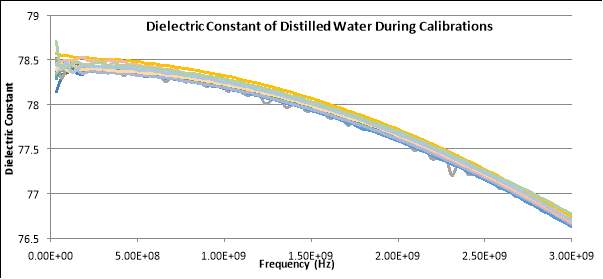
Figure 6: Dielectric constant of distilled water during calibrations
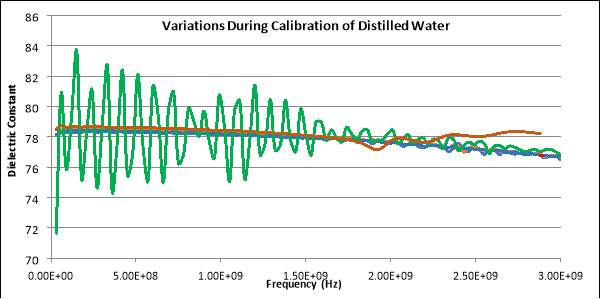
Figure 7: Variations during calibration of distilled water
Appendix E: Scatterplots of Dielectric Constant and Loss Factor
Figure 8: Scatterplot of Dielectric Constant versus the five components at 915 MHz and 2450 MHz with their trend line
Figure 9: Scatterplot of Loss Factor versus the five components at 915 MHz and 2450 MHz with their trend line
Appendix F: One-Way ANOVA Results
One-way ANOVA: DC 915MHz, 915 Eqn
Method
Null hypothesis All means are equal
Alternative hypothesis At least one mean is different
Significance level α = 0.05
Equal variances were assumed for the analysis.
Factor Information
Factor Levels Values
Factor 2 DC 915MHz, 915 Eqn
Analysis of Variance
Source DF Adj SS Adj MS F-Value P-Value
Factor 1 0.0 0.000 0.00 0.999
Error 248 46074.4 185.784
Total 249 46074.4
The null hypothesis can be accepted. The dielectric constant observed through experimentation and through the regression equation have similar means.
Model Summary
S R-sq R-sq(adj) R-sq(pred)
13.6303 0.00% 0.00% 0.00%
Means
Factor N Mean StDev 95% CI
DC 915MHz 125 26.31 15.95 ( 23.90, 28.71)
915 Eqn 125 26.304 10.825 (23.903, 28.705)
Pooled StDev = 13.6303
One-way ANOVA: DC 2450 MHz, 2450 Eqn
Method
Null hypothesis All means are equal
Alternative hypothesis At least one mean is different
Significance level α = 0.05
Equal variances were assumed for the analysis.
Factor Information
Factor Levels Values
Factor 2 DC 2450 MHz, 2450 Eqn
Analysis of Variance
Source DF Adj SS Adj MS F-Value P-Value
Factor 1 0.0 0.003 0.00 0.996
Error 248 38988.9 157.213
Total 249 38988.9
The null hypothesis can be accepted. The dielectric constant observed through experimentation and through the regression equation have similar means.
Model Summary
S R-sq R-sq(adj) R-sq(pred)
12.5385 0.00% 0.00% 0.00%
Means
Factor N Mean StDev 95% CI
DC 2450 MHz 125 22.73 14.63 ( 20.52, 24.94)
2450 Eqn 125 22.722 10.017 (20.514, 24.931)
Pooled StDev = 12.5385
One-way ANOVA: LF 915 MHz, 915 Eqn
Method
Null hypothesis All means are equal
Alternative hypothesis At least one mean is different
Significance level α = 0.05
Equal variances were assumed for the analysis.
Factor Information
Factor Levels Values
Factor 2 LF 915 MHz, 915 Eqn
Analysis of Variance
Source DF Adj SS Adj MS F-Value P-Value
Factor 1 0.00 0.0039 0.00 0.991
Error 248 6853.91 27.6367
Total 249 6853.91
The null hypothesis can be accepted. The dielectric loss factor observed through experimentation and through the regression equation have similar means.
Model Summary
S R-sq R-sq(adj) R-sq(pred)
5.25706 0.00% 0.00% 0.00%
Means
Factor N Mean StDev 95% CI
LF 915 MHz 125 9.279 6.297 (8.353, 10.205)
915 Eqn 125 9.271 3.952 (8.345, 10.197)
Pooled StDev = 5.25706
One-way ANOVA: LF 2450 MHz, 2450 Eqn
Method
Null hypothesis All means are equal
Alternative hypothesis At least one mean is different
Significance level α = 0.05
Equal variances were assumed for the analysis.
Factor Information
Factor Levels Values
Factor 2 LF 2450 MHz, 2450 Eqn
Analysis of Variance
Source DF Adj SS Adj MS F-Value P-Value
Factor 1 0.00 0.0000 0.00 1.000
Error 248 4196.49 16.9213
Total 249 4196.49
The null hypothesis can be accepted. The dielectric loss factor observed through experimentation and through the regression equation have similar means.
Model Summary
S R-sq R-sq(adj) R-sq(pred)
4.11355 0.00% 0.00% 0.00%
Means
Factor N Mean StDev 95% CI
LF 2450 MHz 125 8.305 5.030 (7.580, 9.029)
2450 Eqn 125 8.305 2.922 (7.580, 9.029)
Pooled StDev = 4.11355
Cite This Work
To export a reference to this article please select a referencing stye below:
Related Services
View allRelated Content
All TagsContent relating to: "Food and Nutrition"
Food and Nutrition studies deal with the food necessary for health and growth, the different components of food, and interpreting how nutrients and other food substances affect health and wellbeing.
Related Articles
DMCA / Removal Request
If you are the original writer of this dissertation and no longer wish to have your work published on the UKDiss.com website then please:

